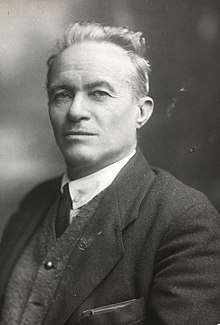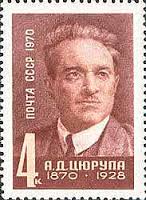Alexander Tsiurupa
Alexander Dmitrievich Tsiurupa (Russian: Алекса́ндр Дми́триевич Цюру́па, September 19 (O.S. October 1) 1870, Oleshky — May 8, 1928, Mukhalatka village of Oliva urban-type settlement, Crimea) was a Bolshevik leader, Soviet stateman and Party figure.
- 1917—1921 — Vice Chairman and, later, Chief of food of RSFSR
- 1922—1923 — Vice Chairman of Sovnarkom of RSFSR, USSR
- 1923—1925 — Chairman of Gosplan of USSR
- 1925—1928 — Narkom of external and internal trade of USSR

On his official duties he faced a tough problem of food supplies of the starving newly created republic. In October 1917 he successfully organized transport of grain, seized from Ukrainian farmers, to Petrograd. He was elected member of the Party Central Committee at the 12th, 13th, 14th and 15th congresses of the Communist Party.[1]
Prodotryads

On May 8, 1918, on the Sovnarkom meeting he suggested the introduction of a food rationing across the country. That was done by a Decree of VTsIK central executive committee on May 13, 1918. He was also one of the organizers of the so-called foodgroups (prodotryad, Russian: продотряд), the groups of workers made for the purpose of stocking up grain and other food rations in an effort to supply the various industrial centers and the Red Army.[2]
First prodotryads formed of workers, soldiers and seamen of Petrograd and Moscow committees were sent to the grain-producing areas in November 1917. From the beginning of 1918 as the starvation became a threat once again, prodotyads appeared in most of the industrial centers.
Participation was voluntarily, on the recommendation of the local soviets and Party leaders.
Price was fixed. Sometimes the food was requisitioned from kulaks considered the "saboteurs".
Acquired food was divided: half taken by the organisation which sent the prodotryad and half was donated to Narkomprod (People's Commissariat for the Food Supply).
With an emergence of NEP, the new economic policy, prodotryads were disbanded in 1921.
References
- Lenin: 158. TO A. D. TSYURUPA
- Продотряды Archived 2008-10-21 at the Wayback Machine, 22.10.2003, RUDN (in Russian)